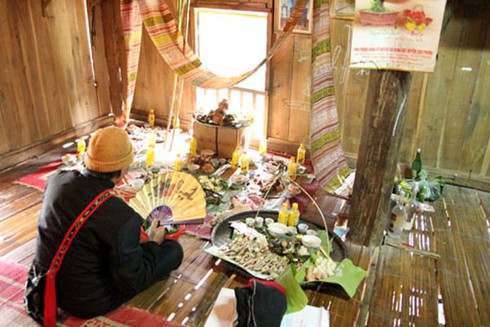When the Lunar New Year comes, each household prepares a meal to offer the ancestors and genies.
Every family, regardless of their economic circumstances, are supposed to raise a pig to prepare the pork dishes for this meal. A family which has a pig at Tet is considered to have thrived that year.
Bui Van Luan of Chieng 4 hamlet said, “On the 27th day of the last lunar month, all family members go to their ancestors’ graveyard to tidy up and invite the ancestors home to celebrate Tet. On the 29th day of the last month a pig is slaughtered to prepare the Tet dishes.
That night, Chung cakes are wrapped and boiled. All family members wake up at 3 or 4 o’clock the next morning to prepare a tray of offerings in the hope that the ancestors will help their descendants prosper.”
The process of making Tet dishes must be done carefully. Pork is cut into pieces and hung around the house without being washed with water.
Seeing the hanging meat, visitors will know what success the host family had in business last year. After being thoroughly boiled, the pig’s viscera are also hung up.
The number of courses on a Tet offering tray depends on each household. A family often prepares seven courses. At Tet, Muong Vang people worship their ancestors, on the maternal side and the kitchen god.
Bui Van Bien, a shaman in Tan Lap commune, Hoa Binh province, said “An offering tray prepared by a Lang Muong or Muong chief is almost the same as a normal tray in terms of arrangement and display.
But a Muong chief adds additional fruits and trays because they have to worship the king and the village tutelary god. The Muong chief’s worship ritual usually begins earlier and lasts longer than a normal ritual which only lasts from morning till noon.”
Other offerings include Chung cakes, a bottle of rice wine, sticky rice, cash, and betel and areca nuts and leaves. Indispensable items are brocade cloth, clothing, a silver necklace, and a belt chain. A local shaman is invited to lead the ritual.
Bui Thanh Vuon of Chieng hamlet said “Each offering tray has a different meaning. A family that worships both the father’s side and the mother’s side prepares two different trays. The only difference is the tray in memory of the god of the soil holds 5 pairs of chopsticks or 7, or 3, depending on the family.”
The ritual, called “Huong voong”, usually concludes after an hour. The tray is then taken down so the descendants can enjoy the offerings. Family members gather around the New Year’s tray and exchange Tet wishes.




